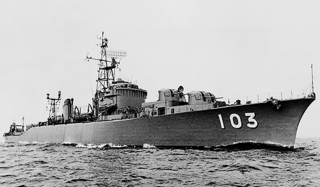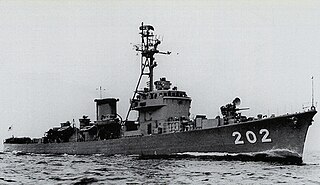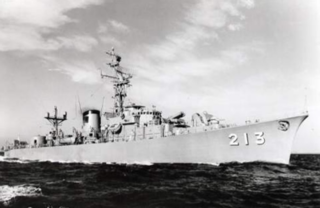
The Kongō class of guided-missile destroyers in the Japan Maritime Self-Defense Force are equipped with the Aegis Combat System, and is the first of few ship classes outside the United States to have that capability. Following a decision made in December 2003, Japan is upgrading their Kongo-class destroyers with Aegis Ballistic Missile Defense System. The upgrade involves a series of installations and flight tests to take place from 2007 to 2010. JS Kongo was the first ship to have the BMD upgrade installed.

The Murasame-class destroyer is a class of destroyers, serving with the Japan Maritime Self-Defense Force (JMSDF). This is the first class of the second-generation general-purpose destroyers of the JMSDF.

The Haruna-class destroyer was a destroyer class built for the Japan Maritime Self-Defense Force (JMSDF) in the early 1970s. These helicopter carrying destroyers (DDH) were built around a large central hangar which housed up to three helicopters.

The Tachikaze-class destroyer was a second generation guided missile destroyer class, formerly in service with the Japan Maritime Self-Defense Force (JMSDF). The ships of this class have had successive improvements after their completion, especially to their C4I systems. These air-defense warships are the natural successor to the first generation air-defense ship, the Amatsukaze-class destroyer, and they were in turn, followed by newer air-defense ships, the Hatakaze class.

JDS Amatsukaze (DDG-163) was a guided missile destroyer (DDG) of the Japan Maritime Self-Defense Force (JMSDF), and the only ship of her class. She was the first Japanese surface combatant equipped with surface-to-air missiles.

The Ayanami class was a destroyer class built for the Japan Maritime Self-Defense Force (JMSDF) in the late 1950s. The primary purpose was anti-submarine warfare, so this class was classified as "DDK" unofficially.

The Murasame-class destroyer was a destroyer class built for the Japan Maritime Self-Defense Force (JMSDF) in the late 1950s as a successor to the Ayanami-class destroyers. Like its predecessor, its main task was anti-submarine warfare, but its improved weaponry also enabled it to perform better in the anti-air role, so this class was classified as "DDA" unofficially.

The Akizuki-class destroyer was a destroyer class built for the Japan Maritime Self-Defense Force (JMSDF) in the late 1950s. This class was planned to be a flotilla leader with the enhanced command and control capability, so sometimes this class was classified as the "DDC" unofficially.

JDS Akebono (DE-201) was a destroyer escort of the Japanese Maritime Self-Defense Force. Akebono was one of the first indigenous Japanese warships to be built following World War II. Akebono was laid down in 1954 as a steam turbine powered "B type" ASW escort, the only ship of its class, for comparison with two similar diesel powered ships, the Ikazuchi-class destroyer escorts. Akebono entered service in 1956 and remained in use until 1976.

The Ikazuchi-class destroyer escort was a destroyer escort class built for the Coastal Safety Force in the late 1950s.

The Isuzu-class destroyer escorts were four destroyer escorts built for the Japan Maritime Self-Defense Force (JMSDF) in the early 1960s. The latter two were quite different from the earlier two vessels in their propulsion and weaponry, so sometimes they were classified as the "Kitakami class".

The Chikugo-class destroyer escort was a class of destroyer escorts built by the Japanese Maritime Self-Defense Force as the successor of the Isuzu class, with the same ASW mission. This class was followed by JDS Ishikari. This is the first Japanese destroyer escort class to carry ASROC anti-submarine missiles.

JS Sazanami (さざなみ) is the fourth vessel of the Takanami-class destroyers of the Japan Maritime Self-Defense Force (JMSDF).

Type 81 Fire Control System (FCS-2) is a Japanese shipboard gun and missile fire-control system. This series of systems has been installed on destroyers of the Japan Maritime Self-Defense Force built between FY1977 and FY2001 to control medium-caliber guns and Sea Sparrow missiles, including ESSM.

JDS Asakaze (DDG-169) is the second ship of the Tachikaze-class destroyer built for the Japan Maritime Self-Defense Force (JMSDF).

JDS Ikazuchi (DE-202) is the lead ship of Ikazuchi-class destroyer escort of Japan Maritime Self-Defense Force.

JDS Isuzu (DE-211) is the lead ship of the Isuzu-class destroyer escorts of the Japan Maritime Self-Defense Force (JMSDF).

JDS Mogami (DE-212) is the second ship of Isuzu-class destroyer escort of Japan Maritime Self-Defense Force (JMSDF).

JDS Kitakami (DE-213) is the third ship of Ikazuchi-class destroyer escort of Japan Maritime Self-Defense Force.

JDS Ōi (DE-214) is the fourth ship of Isuzu-class destroyer escort of Japan Maritime Self-Defense Force.


















